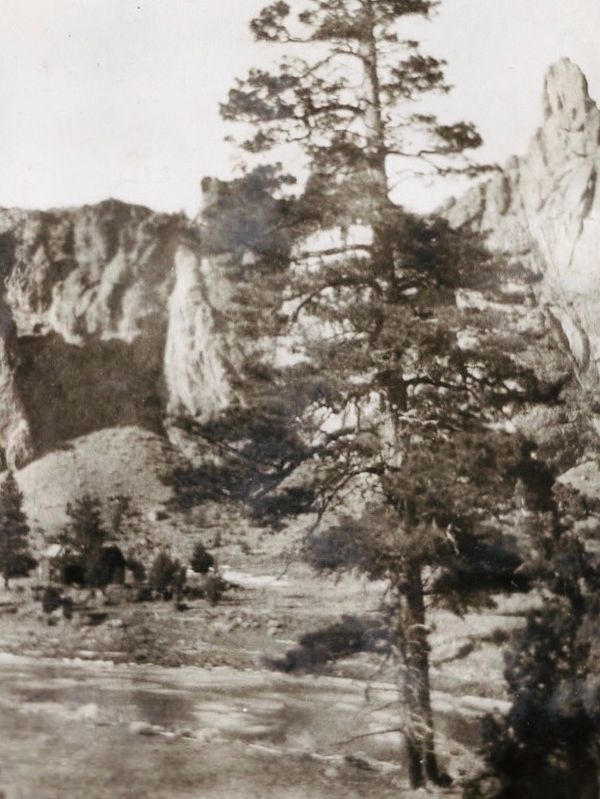Those of us who were part of Smith history won't forget our days on the tuff and basalt soaring high above the Crooked River. The success of Smith climbing resulted from the collective energy of each generation opening the door for the breakthroughs of the next. I learned from those who came before me, and young climbers throughout the country are influenced by what happened here. So many people have contributed it’s impossible to even scratch the surface with this history, as space limitations forced me to gloss over or completely ignore many pioneers. Until an entire book does full justice to Smith history, I apologize to those whose accomplishments were ignored, or not given the credit they deserved.
SMITH ROCK HISTORY - 8000 BC to 1960
Millennia before the arrival of the first climbers, native Americans passed through the Smith Rock region. Archaeologist Luther Cressman discovered hand-woven sandals at nearby Fort Rock in 1938 - radiocarbon testing dated the sandals to roughly 8,000 B.C. The only remnants of Smith's original locals are rare discoveries of perfect arrowheads, meticulously crafted from obsidian.
Little is known about the connection between indigenous people and Smith Rock spanning thousands of years. But Wilson Wewa’s book, “Legends of the Northern Paiute” published in 2017, shares tales passed down through untold generations. The legend of Smith’s creation arose from a time when the region was called the “animal village”, because “all the animals used to live there.” Frustrated by the foolishness of the people that lived there, Coyote (the co-creator of the world, along with Wolf) “turned them all into rock. They’re still up there today…”
The eeriest legend tells the story of a giant cannibal named Nuwuzo’ho who wandered the land with his spear in a time when “animals were the people of the earth”. He would look for rising trails of smoke, knowing that it would lead him to “animal people” to eat. But Coyote tricked Nuwuzo’ho into a contest to stop the killing, and he turned the defeated cannibal into a large rock “still looking out over the land that he used to roam and terrorize.” Today we call that pillar Monkey Face.
In 1813, John Reed and Alfred Seton, trappers from John Jacob Astor's Pacific Fur Company, were the first white men to travel through Central Oregon. A group of settlers led by Stephen Meeks passed by Smith Rock in 1845 during an ill-fated search for a shortcut on the Oregon Trail. At least 23 people died as disease took its toll. In 1858, Andrew McClure led a group of miners looking for the mythical Blue Bucket Mine. On his unsuccessful search, he explored what is now called Smith Rock, referring in his journal to "the noted bluffs of the followers of Meek."
No one knows exactly why these magnificent crags received such a bland name. A tale of a solider named Smith who leaped from the cliffs instead of suffering at the hands of Indians, was long thought to be a myth. In the late 1800s, state senator J.N. Williamson of Prineville spoke about a company of soldiers who camped along the Crooked River during a clash with local Indian tribes in 1863. In the early 2000s, a story arose (supposedly supported by many documents) about Volk Smith, a U.S. Calvary private, who supposedly fell to his death after dislodging a boulder while scouting the area. But the original records of all soldiers serving in the area during that time show no one named “Volk Smith.” And none of the supporting documents have come to light. Until verified, it’s more likely that the name arose from less fanciful origins. In 1867, a group from Eugene visited the region. In a letter to the Albany States Right Democrat newspaper, they described Smith Rock and mentioned that it was named in honor of Linn County sheriff (and future state legislator) John Smith. Boring … but likely true.
A further mystery is why an area of so many cliffs and pinnacles received a singular name. Almost without exception, both local residents and early climbers called the region Smith Rocks, with Smith Rock describing only the southern-most escarpment. The third edition of Macarthur's Oregon Geographic Names confirmed this, attributing the singular name for the entire region to the creation of the state park. Even today, many lifelong residents prefer the plural version.
By the early 1900s, the plains surrounding Smith Rock attracted the first permanent settlers. With the hardships of settling a new land there was little interest in exploring the rocky summits. But about 1909, Otto Wallenburg, his wife, Emily, and four children homesteaded along the Crooked River, below the Monument. He built a wagon road into the canyon (now part of the Homestead Trail) and constructed a home across the river in the pines. He engineered an irrigation canal nearly a mile long and somehow raised vegetables and rye (a dryland farm crop) in the canyon. After acquiring hogs to kill rattlesnakes (their thick skin provided protection against the venom), livestock grazed along the banks of the river for several years


